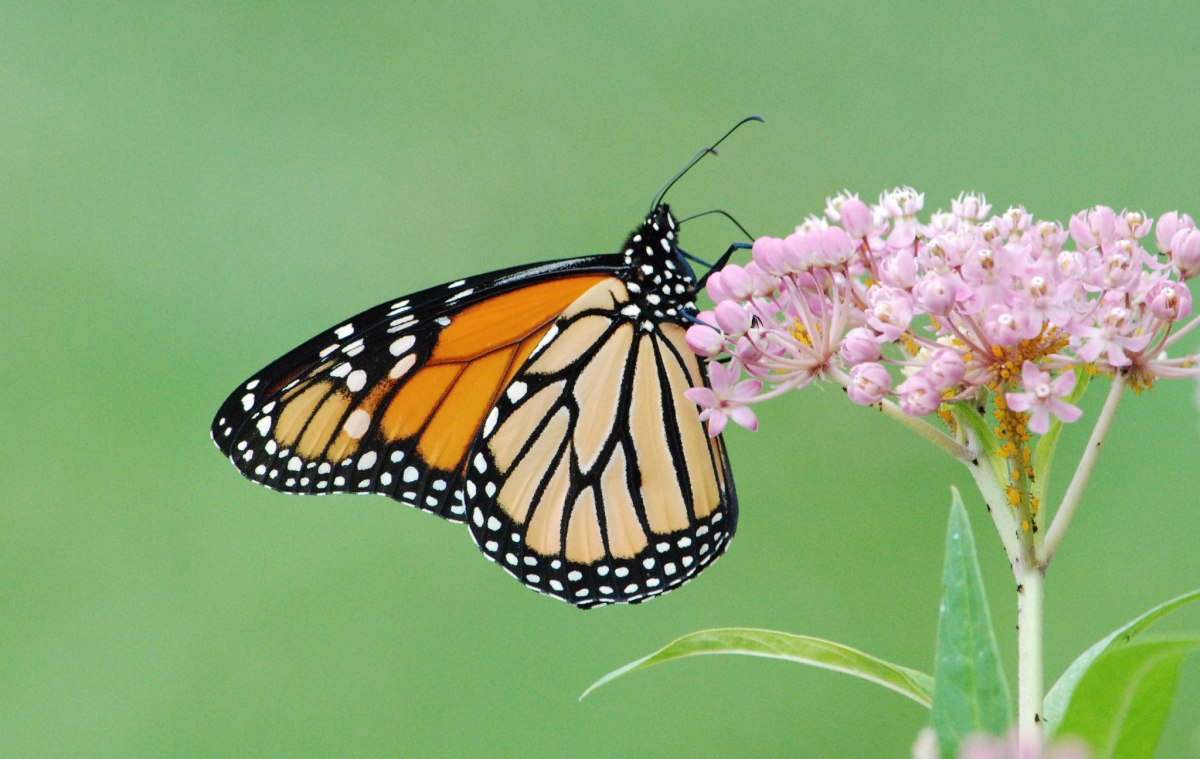
North Carolina is blessed with an abundance of natural wonders. From the mighty Appalachian Mountains to the peaceful coastal plains, this state is a haven for diverse plant life. In this article, we invite you to explore the best North Carolina native plants, unlocking this state’s natural heritage and discovering perfect choices to enhance your landscape.
- What are Native Plants?
- North Carolina Native Flowers
- Cardinal Flower (Lobelia cardinalis)
- New England Aster (Symphyotrichum novae-angliae)
- Blazing Star (Liatris spicata)
- Swamp Milkweed (Asclepias incarnata)
- Eastern Blue Star (Amsonia tabernaemontana)
- Lanceleaf Coreopsis (Coreopsis lanceolata)
- Purple Coneflower (Echinacea purpurea)
- Carolina Phlox (Phlox carolina)
- New York Ironweed (Vernonia noveboracensis)
- North Carolina Native Trees
- North Carolina Native Shrub
- North Carolina Native Fern
- North Carolina Native Vine
- How to Choose Native Plants for North Carolina
- FAQ About North Carolina Native Plants
What are Native Plants?
Native plants naturally occur and have evolved in a specific geographic area without human intervention. These plants have established themselves over an extended period, adapting and thriving in the local environment without requiring assistance or cultivation.
In North Carolina, native plants are adapted to specific climatic conditions, soil types, and wildlife interactions. By embracing and incorporating these native plants into our landscapes, we not only celebrate the beauty of North Carolina but also contribute to preserving its distinct ecological identity.
North Carolina Native Flowers
Cardinal Flower (Lobelia cardinalis)
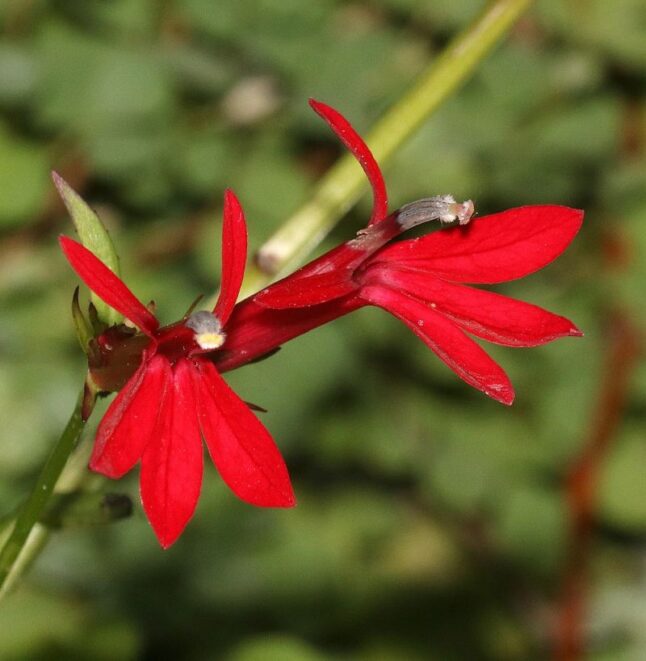
The cardinal flower is an herbaceous perennial that thrives in North Carolina’s landscape. Known for its vibrant display of red flowers, this native plant demands consistent moist or wet soil conditions, so it is commonly found flourishing along stream banks and in wetland areas.
Although this plant is known for its vibrant display of red flowers, the unusual tubular shape makes it difficult for bees to access the nectar and pollen. Nonetheless, that does not stop hummingbirds, the main pollinators, from indulging in it.
Plant type: Herb/Flower
USDA Hardiness Zone: 3a – 9b
Sun: Full sun, partial shade, full shade
Soil: Sand, loam, clay, limestone-based
Duration: Perennial
Foliage: Evergreen
Bloom time: May – October
Water needs: Medium to high
Mature size: 1 – 6 feet
Potential hazards: All parts of this plant are poisonous if eaten in large quantities
Region: Mountains, piedmont, coastal plain
New England Aster (Symphyotrichum novae-angliae)
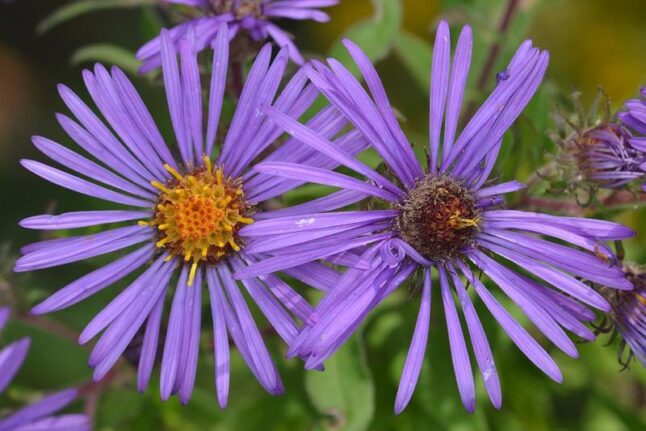
The New England aster is a captivating herbaceous plant that graces North Carolina’s landscape with its showy, bright purple flowers during the fall season. Its stunning blooms serve as a vibrant beacon, attracting an array of pollinators, including bees and butterflies.
In particular, the New England aster holds a special allure for Monarch butterflies, which rely on its nectar as a vital fuel source during their migratory journey.
Plant type: Herb/Flower
USDA Hardiness Zone: 4a – 8b
Sun: Full sun, partial shade
Soil: Sandy, loamy, clay
Duration: Perennial
Foliage: Deciduous
Bloom time: August to November
Water needs: Medium
Mature size: 3 – 6 feet
Potential hazards: Vulnerable to powdery mildew. If plants are grown in poorly-drained clay soils, be mindful of aster wilt.
Region: Mountains, piedmont
Blazing Star (Liatris spicata)
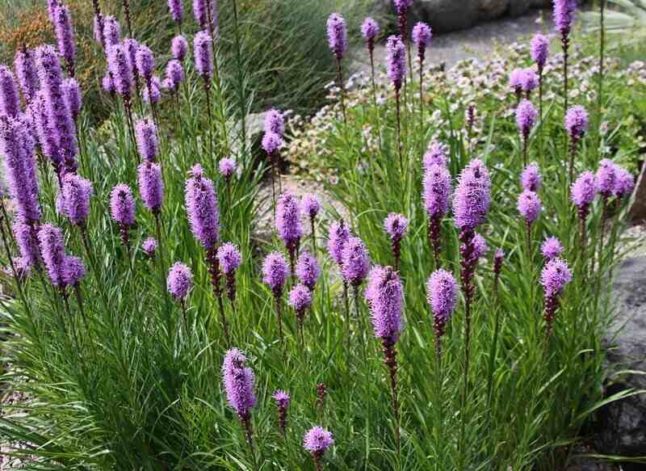
The blazing star is a beautiful herbaceous plant that illuminates North Carolina’s landscapes with its stunning display. In mid-summer, this plant shoots up a tall spiked inflorescence adorned with clusters of vibrant purple-pink blooms.
These eye-catching flowers serve as a magnet for a variety of pollinators, including bees, butterflies, and hummingbirds, which are drawn to the rich nectar source. As the season progresses and the blooms dry out, the blazing star takes on a new role as a seed buffet for birds.
Plant type: Herb/Flower
USDA Hardiness Zone: 3a – 8b
Sun: Full sun
Soil: Moist clay, silt, or sandy soil that’s well-drained
Duration: Perennial
Foliage: Deciduous
Bloom time: July to November
Water needs: Low
Mature size: 3 – 6 feet
Region: Coastal, mountains, piedmont
Swamp Milkweed (Asclepias incarnata)
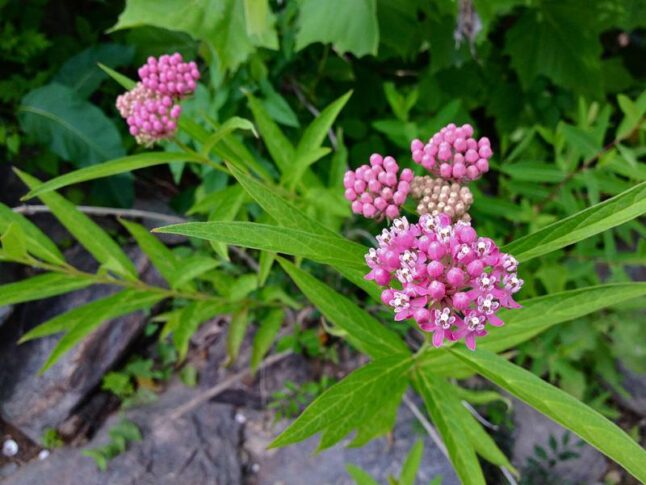
The swamp milkweed is a remarkable native plant that thrives in wet soil conditions, such as swamps, marshes, and bogs, as its name suggests. Notably, the swamp milkweed serves as a vital host plant for Monarch butterflies, providing a safe haven for them to lay their eggs.
Additionally, the swamp milkweed’s resilience and beauty make it an excellent addition to rain gardens.
Plant type: Herb/Flower
USDA Hardiness Zone: 3a – 9b
Sun: Full sun to partial shade
Soil: Clay, loam, well-drained, rich, moist soils
Duration: Perennial
Foliage: Deciduous
Bloom time: June to October
Water needs: High
Mature size: 3 – 5 feet
Potential hazards: All parts of this plant have low-severity poison characteristics, and can cause vomiting and weakness.
Region: Coastal, mountains, piedmont
Eastern Blue Star (Amsonia tabernaemontana)
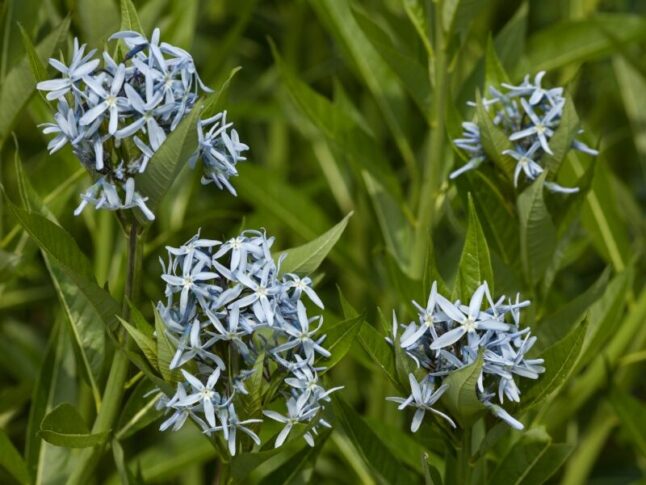
The eastern blue star is a low-maintenance wildflower that graces North Carolina’s landscapes with its beauty. In late spring, it bursts into clusters of light blue star-shaped flowers. This native plant is a host plant for the coral hairstreak butterfly, providing a nurturing environment for its eggs and caterpillars. It also attracts native bees and hummingbirds.
Plant type: Herb/Flower
USDA Hardiness Zone: 3a – 9b
Sun: Full sun, partial shade
Soil: Clay, loam, sand, well-drained, moist soils
Duration: Perennial
Foliage: Deciduous
Bloom time: March to May
Water needs: High
Mature size: 2 – 3 feet
Region: Coastal, mountains, piedmont
Lanceleaf Coreopsis (Coreopsis lanceolata)
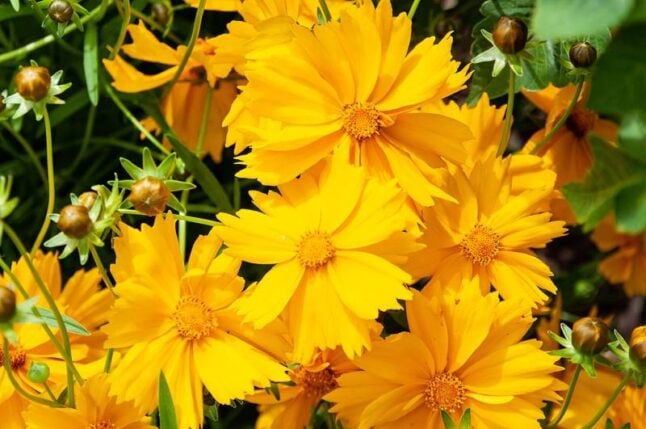
The lanceleaf coreopsis is a resilient and vibrant addition to North Carolina’s landscapes. With its brilliant yellow flowers, it adds a splash of color and cheer to any garden or natural space.
This hardy plant is known for its exceptional durability, as it resists deer and rabbits, making it a reliable choice for gardens in areas with high wildlife activity. The lanceleaf coreopsis is also drought-tolerant and tolerates poor soil quality and intense heat.
Plant type: Herb/Flower
USDA Hardiness Zone: 4a – 9b
Sun: Full sun, partial shade
Soil: Loam, sand, shallow rocky soils with good drainage
Duration: Perennial
Foliage: Deciduous
Bloom time: March to August
Water needs: Medium
Mature size: 1 – 2 feet
Region: Coastal, mountains, piedmont
Purple Coneflower (Echinacea purpurea)
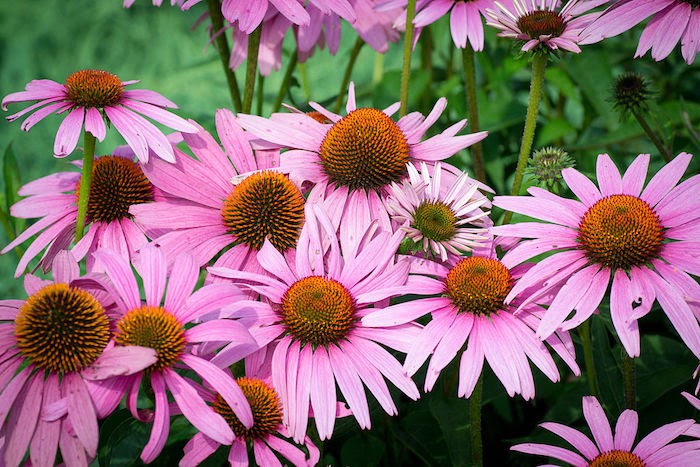
The purple coneflower has stunning pink-purple blooms and distinctive, spiky, cone-shaped centers. This showy flower stands out in gardens and natural areas during the summer season. Once established, this hardy plant requires minimal maintenance and exhibits remarkable drought tolerance.
The purple coneflower is also a pollinator magnet, attracting a diverse array of beneficial insects, butterflies, and bees to its nectar-rich flowers. In addition, the cone-shaped seed heads attract songbirds.
Plant type: Herb/Flower
USDA Hardiness Zone: 3a – 8b
Sun: Full sun, partial shade
Soil: Clay, loam, sand, with high organic matter
Duration: Perennial
Foliage: Deciduous
Bloom time: April to September
Water needs: Medium
Mature size: 3 – 4 feet
Region: Coastal, mountains, piedmont
Carolina Phlox (Phlox carolina)
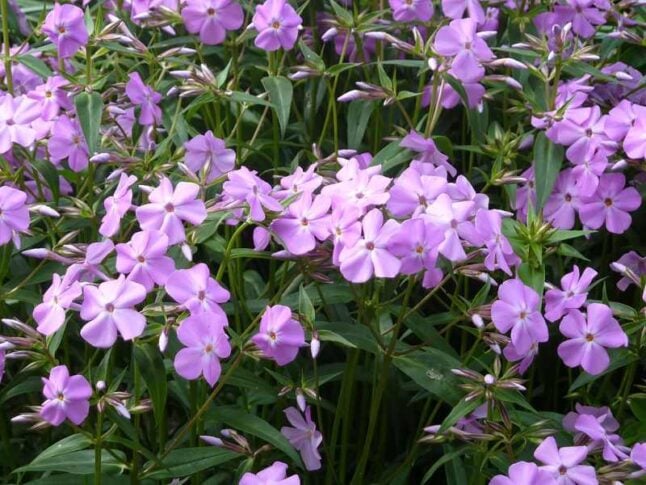
The Carolina phlox is a native flower that thrives in the woodlands, forests, edges, and roadsides of North Carolina. This plant’s blooms are clusters of lavender to pink or white flowers, primarily occurring during the hottest part of the summer.
However, the Carolina phlox often surprises with intermittent reblooms throughout the season, continuing its display until frost arrives.
Plant type: Herb/Flower
USDA Hardiness Zone: 5a – 9b
Sun: Full sun, partial shade, dappled sunlight
Soil: Rich, acid loams and sands
Duration: Perennial
Foliage: Evergreen
Bloom time: May to October
Water needs: Medium to high
Mature size: 1 – 2 feet
Region: Coastal, mountains, piedmont
New York Ironweed (Vernonia noveboracensis)
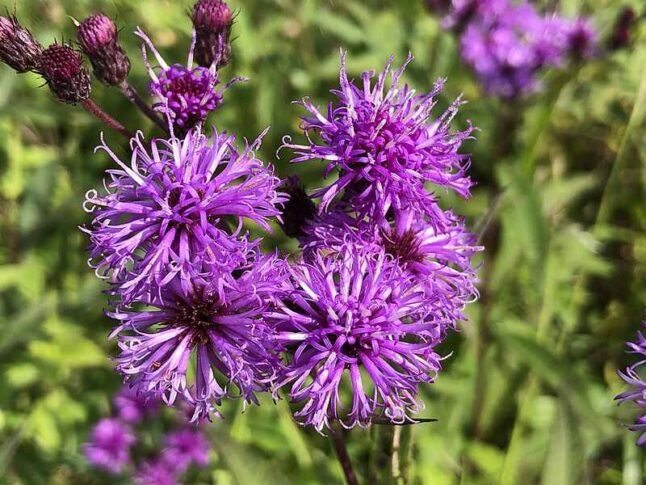
The New York ironweed is a native perennial found all over North Carolina. It has clusters of deep purple flowers that bloom from mid-summer to mid-fall. This plant is easy to care for and adapts to different garden conditions.
Whether you have a sunny spot or partial shade, New York ironweed adds a pop of color to your garden and attracts pollinators.
Plant type: Herb/Flower
USDA Hardiness Zone: 5a – 9b
Sun: Full sun, partial shade
Soil: Moist, clay or loam, with high organic matter
Duration: Perennial
Foliage: Deciduous
Bloom time: August to October
Water needs: Medium
Mature size: 5 – 8 feet
Region: Coastal, mountains, piedmont
North Carolina Native Trees
Red Maple (Acer rubrum)
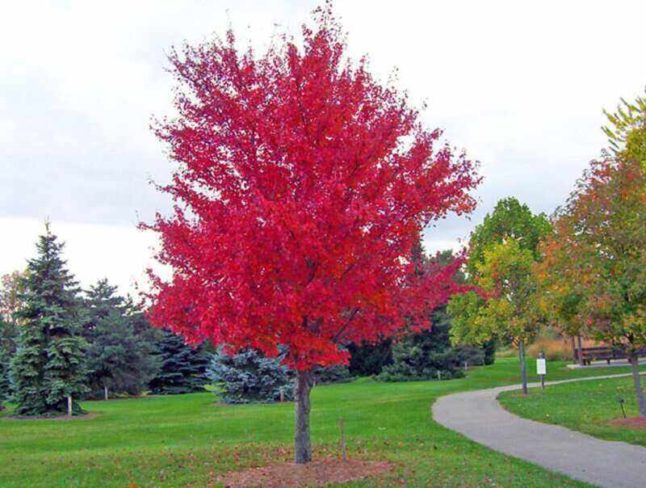
The red maple holds the distinction of being the most abundant native tree in North America. As a shade tree, it provides respite from the sun’s rays, making it a popular choice in landscapes. This versatile tree showcases its brilliance in the fall by being one of the first to display vibrant hues, painting the surroundings with its fiery red, orange, and yellow foliage.
Plant type: Tree
USDA Hardiness Zone: 2a – 9b
Sun: Full sun, partial shade
Soil: Clay, loam, sand, with high organic matter and good drainage
Duration: Perennial
Foliage: Deciduous
Bloom time: March, April
Water needs: Medium
Mature size: 40 – 120 feet
Potential hazards: Toxic to horses
Region: Coastal, mountains, piedmont
Flowering Dogwood (Cornus florida)
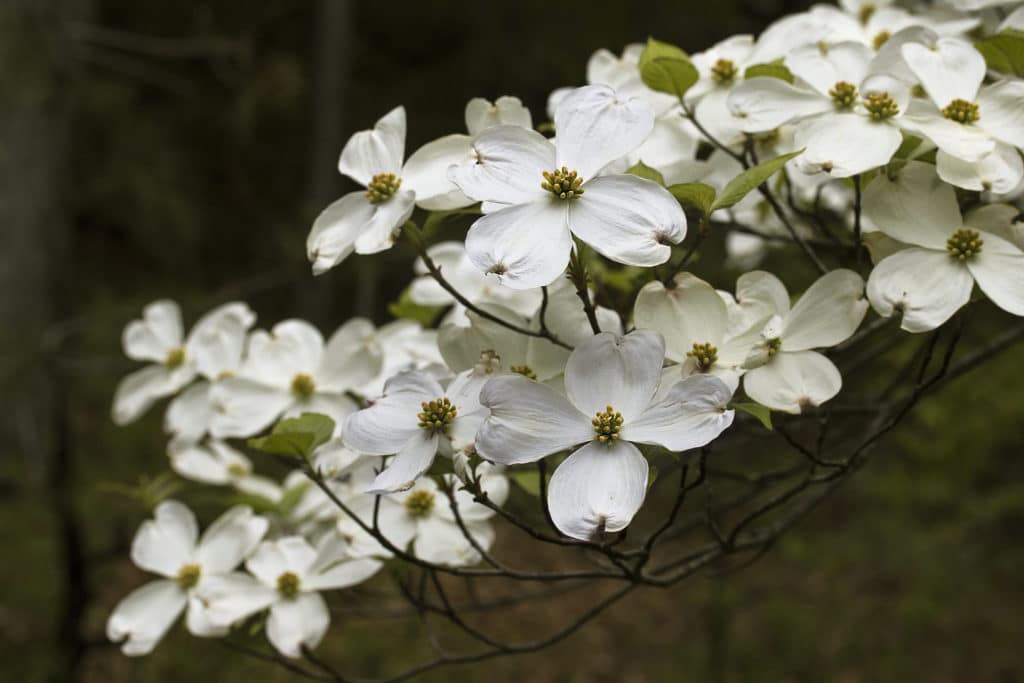
The flowering dogwood is a small yet stunning tree that commands attention. With its graceful spreading crown and enchanting display of long-lasting, shiny, white and pink blooms in the spring, it becomes a focal point in any landscape.
The tree’s distinctive branching pattern, characterized by nearly horizontal branches, adds to its visual appeal. As the seasons progress, the flowers give space to red fruit adorning its branches and scarlet foliage announcing the arrival of fall.
Plant type: Tree
USDA Hardiness Zone: 5a – 9b
Sun: Full sun, partial shade
Soil: Rich, well-drained, clay, loam, or sandy soil
Duration: Perennial
Foliage: Deciduous
Bloom time: March to June
Water needs: Low
Mature size: 15 – 25 feet
Region: Coastal, mountains, piedmont
North Carolina Native Shrub
Catawba Rhododendron (Rhododendron catawbiense)
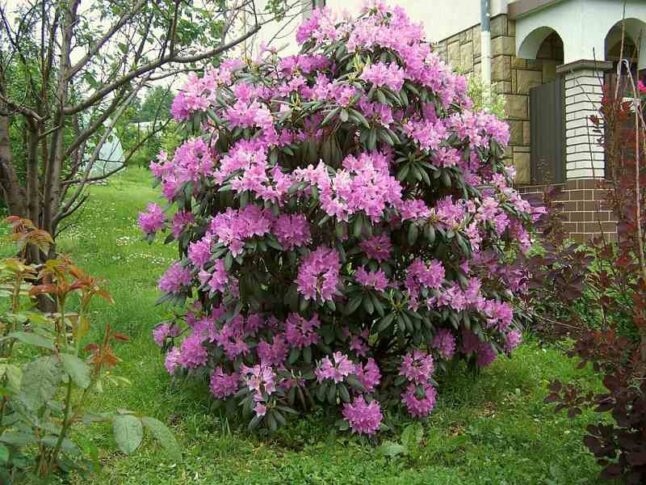
With its large clusters of captivating lavender flowers and glossy leaves, the Catawba rhododendron effortlessly captures attention. Thriving in shaded environments, this rhododendron variety is an ideal choice for woodland gardens, where it displays its resilience by tolerating shade exceptionally well.
However, it’s important to note that this plant is highly toxic, making it unsuitable for homes with children or pets who may be tempted to explore its enticing foliage. While its beauty is undeniable, it’s essential to prioritize safety.
Plant type: Flowering shrub
USDA Hardiness Zone: 4a – 8b
Sun: Full sun, partial shade, full shade
Soil: Well-drained soils, with high organic matter
Duration: Perennial
Foliage: Evergreen
Bloom time: March to June
Water needs: Medium
Mature size: 6 – 10 feet
Potential hazards: All parts contain high-severity poison characteristics
Region: Mountains, piedmont
North Carolina Native Fern
Northern Maidenhair (Adiantum pedatum)
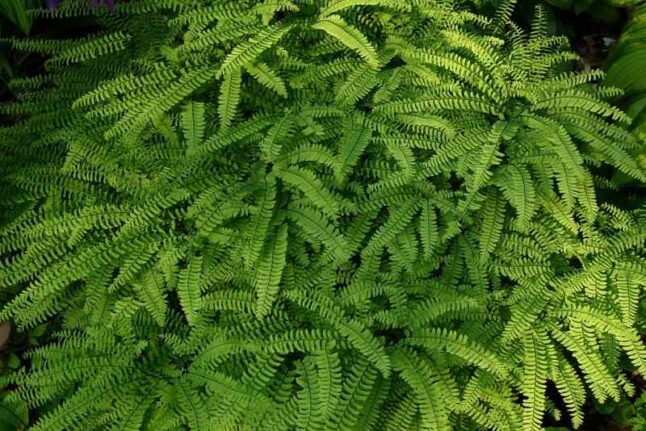
The Northern maidenhair is a delicate fern that adds grace and charm to shaded areas in North Carolina. With its intricate fronds, this fern thrives in environments with limited sunlight. This fern spreads slowly through creeping, branching rhizomes, gradually creating a lush carpet of foliage.
While it exhibits some tolerance to mild drought, it’s important to note that high summer heat can cause the fronds to turn brown.
Plant type: Fern
USDA Hardiness Zone: 3a – 8b
Sun: Partial shade, deep shade
Soil: Acidic, rich, moist, well-drained soils
Duration: Perennial
Foliage: Deciduous
Bloom time (sporulating period): June to November
Water needs: Medium
Mature size: 1 – 3 feet
Region: Coastal, mountains, piedmont
North Carolina Native Vine
Coral Honeysuckle (Lonicera sempervirens)
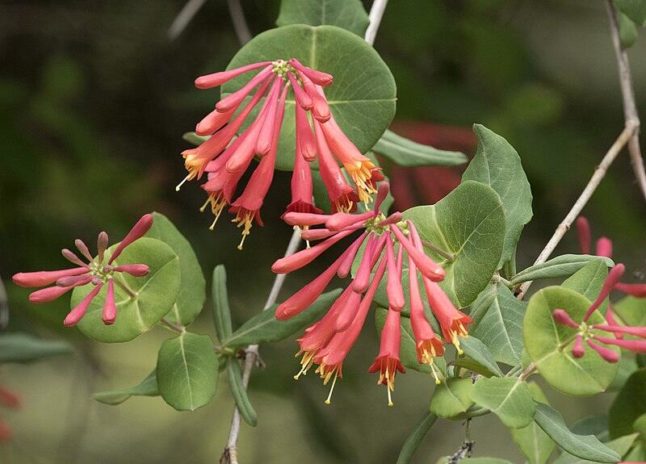
The coral honeysuckle, also known as trumpet honeysuckle, derives its name from its red, trumpet-shaped flowers. As a vine, it requires a support structure to climb upon, but caution should be exercised in choosing its planting location. It can also be used as a ground cover.
Due to its high flammability, it is advisable to avoid planting it near your home. Instead, consider planting it near pergolas, trellises, or other sturdy structures that can provide support while keeping a safe distance from buildings.
Plant type: Vine
USDA Hardiness Zone: 4a – 9b
Sun: Full sun, partial shade
Soil: Tolerates a wide range of soil types, and prefers rich soils
Duration: Perennial
Foliage: Evergreen
Bloom time: March to June
Water needs: Medium
Mature size: 10 – 20 feet
Potential hazards: Fruit is toxic to dogs. Extremely flammable.
Region: Coastal, mountains, piedmont
How to Choose Native Plants for North Carolina
When selecting native plants for your North Carolina landscape, it’s important to consider the specific region you’re in. While the plants mentioned in this article are adapted to all of North Carolina’s regions, not every native plant will thrive in every area:
- For the mountain region, choose plants that can withstand harsh winter temperatures.
- Coastal plain plants should be able to tolerate hot and humid summers.
- The piedmont region welcomes a wide range of native plants, but it’s always wise to check with your local plant nursery.
Additionally, consider the amount of shade in your landscape and the level of maintenance you’re willing to undertake. By considering these factors, you can select the ideal native plants that will thrive in your specific North Carolina environment.
FAQ About North Carolina Native Plants
The Venus flytrap (Dionaea muscipula) is a fascinating and unique plant that is native solely to the regions of North and South Carolina in the United States. This carnivorous plant has become iconic due to its specialized leaves with hinged traps, which snap shut when triggered by unsuspecting prey.
The best grass types for North Carolina vary depending on the region. In the mountain region, cool-season grasses such as Kentucky bluegrass, perennial ryegrass, tall fescue, and fine fescues are well-suited. These grasses tolerate cooler temperatures and can withstand the harsher winters in the mountains.
On the other hand, the coastal plain benefits from warm-season grasses like Bermudagrass, Zoysiagrass, St. Augustinegrass, and centipedegrass. These grasses thrive in the hot and humid summers of the coastal areas.
In the piedmont region, both cool-season and warm-season grasses can be used, providing some flexibility in choosing grass types based on personal preferences and specific landscape conditions.
North Carolina’s state flower is the flowering dogwood (Cornus florida). This beautiful tree, with its showy white or pink blossoms, holds a special place in the hearts of North Carolinians. The flowering dogwood is not only cherished for its delicate and distinctive blooms but also for its significance in the state’s ecosystem and natural heritage.
Bring in the Professionals
Looking for a North Carolina landscaping pro near you to help you choose the best native plants? We have trusted lawn care pros in Charlotte, Raleigh, Asheville, and many more cities across the Tar Heel State.
Main Photo Credit: USFWS Midwest Region / Flickr / Public Domain Mark 1.0